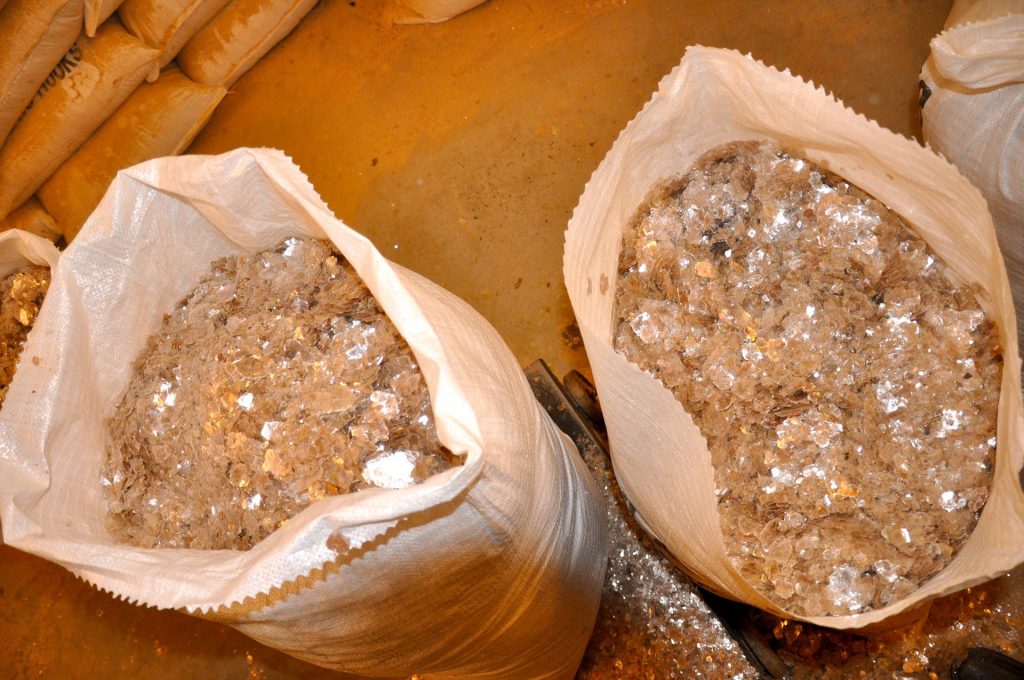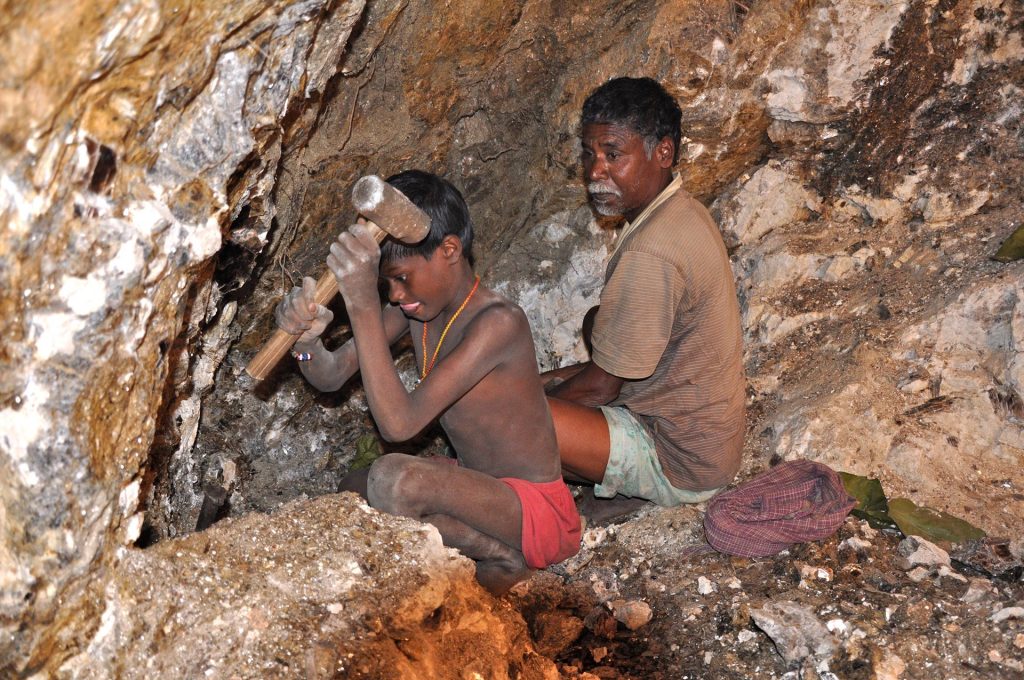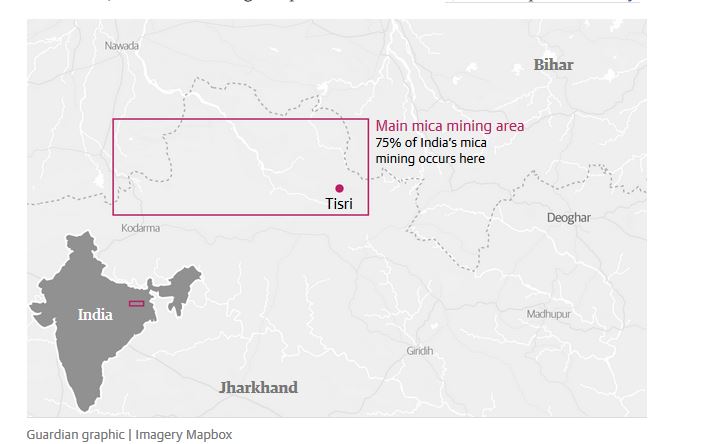Some of the world’s biggest car makers including Vauxhall, BMW, Volkswagen and Audi are launching investigations into their paint supply chains after the Guardian linked their suppliers to illegal mines in India where child labour and debt bondage are widespread.
Children as young as 10 work at mines for mica, a mineral that creates the shimmery car paint used on millions of vehicles around the world.
Although largely unknown to consumers, mica is highly valued for its ability to reflect and refract light. In 2014, the cosmetics industry came under fire for child labour in its mica supply chains, but mica is also widely used by other global industries.
The Indian government has pledged to stamp out child labour in its mica industry, with a small number of official mica mines now monitored for labour and environmental abuses.
Yet illegal mining remains widespread, with child rights campaigners estimating that up to 20,000 children work in hundreds of small-scale mines in northern Jharkhand and southern Bihar.
On visits this year to illegal mines in the Tisri subdistrict in the Indian state of Jharkhand, the Guardian documented children aged 12 mining mica underground in hazardous, leaking mineshafts, hammering glittering rock flakes from walls and carrying heavy loads through slippery tunnels. Above ground, girls as young as 10 were sorting mica from other mined material.
The Guardian has traced mica from three mines in Tisri subdistrict to three Indian exporters: Mohan Mica, Pravin and Mount Hill. One of their biggest customers is Fujian Kuncai, a Chinese company, whose website listed (pdfs now removed) customers including cosmetics giants L’Oréal and Proctor & Gamble as well as PPG and Axalta, two of the leading companies in the world’s $19bn car paint industry.
Many of these children work in mines alongside their parents and siblings, for whom the mine is the only source of income. Many families are bonded to the mines by large debts owed to local moneylenders or mine owners who charge up to 200% annual interest.
Glittering clouds of tiny mica particles swirl around 13-year-old Dharini* as she carries rocks of mica from the mineshaft to where groups of younger children are sorting through piles on the ground.
She says she has worked at mines, carved out of the mountainous hillside, for as long as she can remember and has never gone to school.
“I’ve been helping my mother here at the mine every day because they need my help for the money,” she says. Along with her mother, Dharini gets paid about £5 a week for six days of work.
Her mother, Basanti, has also spent her life working at mines. “Every evening we feel ill after work with nausea and it is difficult to breathe because of the dust but we have no choice, this is the only work.”
When asked if her child goes to school, she said: “My daughter works with me because we need the money to keep the family going.”
A few hours away, at another mine, more children are working alongside their families. Simitra, a 45-year-old mother of two, says the family are all working simply to try to cover the interest on a £200 loan they took out in 2014 after her husband contracted tuberculosis.
None of the families who work here know where the mica they scrape from the rock walls ends up, nor that they are the first link in multiple complex global supply chains stretching around the world.
“Natural mica goes into numerous products without anyone realising, since it is not listed as ingredient in car paints, decorative paints, plastic products, hairdryers, toasters and much more. Child labour is a part of our everyday life but no one knows about it,” said Aysel Sabahoglu, children’s rights officer of Terre des Hommes Netherlands, a Dutch NGO that works to protect children’s rights.
Campaigners say it is impossible to differentiate between mica from legal mines and from the hundreds of small-scale illegal mines in northern Jharkhand and southern Bihar.

India officially produced about 19,000 tonnes of crude and scrap mica in 2013-14, yet it exported more than six times as much – about 128,000 tonnes – according to the latest data (pdf) from the Ministry of Mines.
Mica from illegal mines is sold to networks of local traders, who sell the mineral to Indian export companies. The mica is next transported to Kolkata and shipped to foreign companies who then transform the mica into the pearlescent pigments used in industry.
In emails to the Guardian, Axalta and PPG confirmed that they use natural mica in their paint products. Axalta also confirmed that it sources pearlescent pigments from Fujian Kuncai. PPG declined to say whether it is a Kuncai customer, stating: “As a matter of policy, PPG does not discuss its relationships with specific suppliers.”
PPG and Axalta sell to leading car companies. When contacted by the Guardian, some car firms said they were looking into their suppliers in the light of the allegations. BMW, which owns the Mini brand, said its investigations had found two suppliers with direct links to Kuncai and that an internal investigation had been launched.
Fujian Kuncai said it was conducting extensive inquiries into its three Indian suppliers named in the investigation.
“It is a shock to us that three of our suppliers are mentioned … and that [the Guardian] has linked them to mines involved in child labour,” said Mike Tijdink, European marketing manager for Fujian Kuncai.
“For us it is totally unacceptable that child labour is present in our supply chain and we will act accordingly. The insights presented in your [investigation] differ from our findings over the past years, as our audits on the locations and agreements with our suppliers exclude any involvement in this respect.”
Axalta said: “Fujian Kuncai is a supplier to Axalta … Axalta does use some natural mica that goes into the pearlescent pigments used in certain paint formulations. The Axalta standard contract template and terms of purchase – which are in place with Fujian Kuncai – stipulate that its suppliers are prohibited from using forced labour.
“It goes on to require that suppliers comply with all applicable laws, codes, rules, regulations, orders and ordinances, including those relating to environmental protection, energy, and labour and all applicable industry codes and standards.”

Photograph: Peter Bengtsen
A PPG spokesperson said: “PPG does not tolerate the use of improper labour practices by any supplier. PPG’s supplier code of conduct prohibits the use of child labour, and indicates that suppliers shall adhere to the minimum employment age limit defined by national law or regulation, and shall comply with relevant International Labour Organisation standards.”
Although mica is also mined in China, the US and Europe, Jharkhand and Bihar account for an estimated 25% of the world’s total production. About 60% of mica mined in these states is made into pearlescent pigments for export.
Phil Bloomer, executive director of the Business & Human Rights Centre, said companies using natural mica from India must start to acknowledge the risk of products from illegal unregulated mines entering their supply chains.
“There is a huge gap in what India apparently produces and actually exports – clearly indicating existence of illegal mining and operations,” he said.
“Nobody wants the curse of forced and child labour in their supply chains, but, with large-scale hidden production, it takes a lot more than a simple audit of your apparent ‘supplier’ to eliminate modern slavery from your supply chain. Too many companies are buying with one eye open to the price, and the other closed to the abuse.”
Fujian Kuncai said its suppliers must sign a contract that no children work in factories or mines. It has contributed £500,000 to a project with Terre des Hommes that aims to eradicate child labour in mica communities in Jharkhand over three years.
*Identities of those interviewed at the mines protected
Car company responses
Volkswagen (which owns Audi):
Child labour is prohibited by our sustainability standards and is not tolerated by the Volkswagen Group … Our paint suppliers have assured our ad hoc team that they are compliant with our sustainability standards. Some of our suppliers have confirmed a business relationship with the Chinese company Kuncai. We are engaging with these relevant suppliers to further evaluate the allegations and investigate whether or not a corrective action plan shall be implemented.
Vauxhall (part of GM group):
GM expects our suppliers to be fair, humane and lawful employers, and to enforce similar requirements from their sub-suppliers. These expectations are outlined in GM’s standard purchase contract terms and conditions, which reinforce our zero-tolerance policy against the use of child labour, abusive treatment of employees or corrupt business practices in the supply of goods and services to GM. GM will conduct a full investigation of these suppliers regarding the allegations.
BMW:
“Our supply chain response team is investigating your claim. Initial findings suggest that two of our suppliers may indeed obtain materials indirectly from Fujian Kuncai Fine Chemicals Co. Ltd. In accordance with our guidelines, we have asked these two suppliers to respond to these allegations … The BMW Group does not tolerate child labour in its supply chain. If the allegations are substantiated, we will do everything to ensure that the company involved is no longer part of our supply chain in the future.


